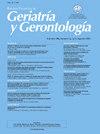身体虚弱的老年人在急诊室就诊
Q3 Medicine
引用次数: 0
摘要
管理老年人的护理虚弱目前是一个主要的挑战,特别是在急诊科(ED)和急症医疗单位(AMU)。本文的目的是描述使用医疗资源的病人虚弱入院的AMU。方法前瞻性、描述性和观察性研究,研究时间为2022年3月至2023年3月。入住AMU的患者≥85岁,伴有中晚期虚弱和<;从选定的风险群体(来自养老院、痴呆症和晚期慢性疾病)中选取85岁的老人进行分析。根据临床虚弱量表(CFS)对虚弱程度进行分类。评估了人口统计数据、临床数据、传统住院和传统住院替代方案(中间护理、家庭医院)、高级护理计划、出院后3个月死亡率和出院后72小时至28天的再入院率。结果共纳入354例患者,其中女性202例(57%);平均年龄87.7±3.83岁。212名(60%)患者接受了替代传统住院治疗,120名(56.6%)接受了中间护理,92名(43.4%)接受了家庭住院治疗。138例(39%)患者曾接受过初级保健评估,85例(24%)患者有预先护理计划。出院后3个月死亡78例(22%),再入院73例(20.6%)。结论:AMU是为虚弱的老年人量身定制紧急护理的关键领域,优化传统住院治疗的替代方案的使用,并提前规划急性发作和未来的代偿。本文章由计算机程序翻译,如有差异,请以英文原文为准。
Adultos mayores con fragilidad que consultan en Urgencias
Introduction
Managing the care of older adults with frailty is currently a major challenge, especially in the Emergency Department (ED) and the Acute Medical Unit (AMU). The aim of this paper is to describe the use of healthcare resources of patients with frailty admitted to the AMU.
Methods
Prospective, descriptive and observational study, from March 2022 to March 2023. Patients admitted to the AMU ≥ 85-years-old with moderate-advanced frailty and < 85-years-old from selected risk groups (from nursing homes, dementia and advanced chronic disease) were analysed. The degree of frailty was classified according to the Clinical Frailty Scale (CFS). Demographic data, clinical data, conventional hospitalisation and alternatives to conventional hospitalisation (intermediate care, hospital at home), advanced care planning, 3-months mortality after discharge and hospital readmissions between 72 hours and 28 days after discharge were assessed.
Results
A total of 354 patients were studied, of whom 202 (57%) were female; mean age 87.7 ± 3.83 years. 212 (60%) patients were admitted to some alternative to conventional hospitalisation, 120 (56.6%) intermediate care and 92 (43.4%) hospital at home). 138 (39%) patients had a previous assessment by primary care and 85 (24%) patients had advance care planning. 3-months mortality after discharge was 78 patients (22%) and readmissions were 73 patients (20.6%).
Conclusions
The AMU is a key area for tailoring urgent care for older people with frailty, optimising the use of alternatives to conventional hospitalisation and planning ahead for acute episode and future decompensation.
求助全文
通过发布文献求助,成功后即可免费获取论文全文。
去求助
来源期刊

Revista Espanola de Geriatria y Gerontologia
Medicine-Medicine (miscellaneous)
CiteScore
1.90
自引率
0.00%
发文量
62
审稿时长
85 days
期刊介绍:
Una revista de gran prestigio por sus artículos originales de investigación y revisiones. Permite cubrir todas las áreas de la medicina pero siempre desde la atención al paciente anciano, y está presente en los más reconocidos índices internacionales.
 求助内容:
求助内容: 应助结果提醒方式:
应助结果提醒方式:


